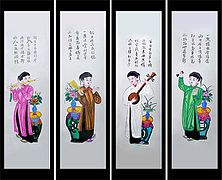| Part of a series on the |
| Culture of Vietnam |
|---|
 |
| History |
| People |
| Languages |
| Traditions |
| Cuisine |
| Festivals |
| Religion |
| Art |
| Literature |
| Music |
| Media |
| Sport |
| Monuments |
| Symbols |
The Vietnamese zodiac (Vietnamese: Mười hai con giáp) is the traditional Vietnamese classification scheme based on the lunar calendar that assigns an animal and its reputed attributes to each year in a repeating 12-year cycle. The Viet lunar calendar is divided into 60-year cycles known as hồi. Each of these consists of five 12-year animal cycles.
Zodiac
The Vietnamese zodiac is originated from the Chinese zodiac in its usage and arrangement of animals, but replaces the ox with the water buffalo and the rabbit with the cat. The Vietnamese zodiac uses cat instead of rabbit due to the pronunciation of the rabbit in Chinese writing: 卯 is very similar to the Vietnamese word Mèo for cat.
| Zodiac animal sign | Vietnamese zodiac | Characteristic |
|---|---|---|
| Rat | Tý | Welcomed as a bringer of good luck |
| Water buffalo | Sửu | Associated with riches achieved through hard work |
| Tiger | Dần | Warm-hearted yet fearsome, and brave in the face of danger |
| Cat | Mão | Known to be tranquil, realistic, intelligent and artistic |
| Dragon | Thìn | Imperial symbol, associated with the male element yang |
| Snake | Tỵ | Enigmatic, wise, and like to live well |
| Horse | Ngọ | Signifies freedom and confidence |
| Goat | Mùi | Associated with creativity and good taste |
| Monkey | Thân | Versatile and mischievous; associated with inventors, entertainers, and anything ingenious |
| Rooster | Dậu | Brave and resilient, but can also be self-absorbed and pretentious |
| Dog | Tuất | Considered lucky, loyal, and likeable |
| Pig | Hợi | Honest, patient, and also associated with virility |
See also
References
Bibliography
- Sterling, Richard (2011). DK Eyewitness Travel Guide: Vietnam and Angkor Wat. Penguin. ISBN 978-0-75668-740-3.
- Taylor, K. W. (2018). Essays Into Vietnamese Pasts. Cornell University Press. ISBN 978-1-50171-899-1.
- Noppe, Catherine; Hubert, Jean-François (2018). Art of Vietnam. Parkstone International. ISBN 978-1-78310-725-4.